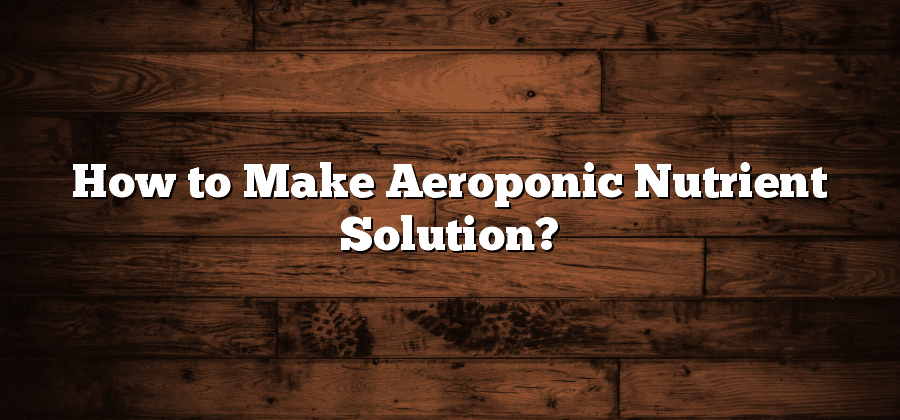Understanding the Role of Nutrient Solution
Nutrient solution plays a vital role in the growth and development of plants in aeroponics systems. It serves as the primary source of essential elements that are necessary for plants to thrive without the use of soil. The nutrient solution contains a carefully balanced mixture of macronutrients such as nitrogen, phosphorus, and potassium, as well as micronutrients like iron, zinc, and copper. These nutrients are dissolved in water and delivered directly to the plant roots, providing them with the nourishment they need to carry out vital physiological processes, such as photosynthesis, respiration, and reproduction.
Properly formulating and maintaining the nutrient solution is essential to ensure optimal plant growth and yield. The nutrient solution must be carefully measured and mixed in the correct proportions to meet the specific needs of the plants being grown. This requires a thorough understanding of the nutrient requirements of different plant species and the ability to adjust the nutrient solution accordingly. It is also important to regularly monitor and adjust the pH level of the nutrient solution, as it can affect the availability of nutrients to the plants. By closely managing the nutrient solution, growers can provide their plants with the necessary elements to thrive and achieve maximum productivity.
Selecting the Right Nutrients for Aeroponics
When it comes to aeroponics, selecting the right nutrients is crucial for the success of your plants. The nutrient solution used in aeroponics serves as the sole source of essential elements for plant growth and development. Unlike traditional soil-based farming, where plants can extract nutrients from the soil, aeroponic plants rely on the nutrient solution misted onto their roots. Therefore, it is important to choose nutrients that are specifically designed for aeroponic systems and provide all the necessary elements in the right proportions.
Before selecting the nutrients for your aeroponic system, it’s important to consider the specific needs of your plants. Different plants have varying nutrient requirements, so it is essential to choose a nutrient solution that matches the needs of the crops you are growing. Additionally, it is advisable to opt for a nutrient solution that is formulated for the specific growth stage of your plants, as their nutrient requirements may change throughout their life cycle. By selecting the right nutrients for your aeroponic system, you can ensure that your plants receive the necessary elements for healthy growth and abundant yields.
Properly Measuring and Mixing Nutrients
To ensure successful aeroponic plant growth, it is imperative to properly measure and mix nutrients. Accurate measurements and correct nutrient ratios are essential for providing plants with the necessary elements for optimal development. Neglecting this step can lead to nutrient deficiencies or excesses, resulting in stunted growth or even plant death.
When measuring nutrients, precision is key. Use a reliable scale or measuring tools to ensure accurate quantities. It is recommended to measure nutrients separately before combining them in a specific order. This prevents any potential reaction between the components and allows for easier adjustments if necessary. Additionally, always follow the instructions provided by the nutrient manufacturer to ensure the correct dosage. Once the nutrients are measured, they can be mixed in a clean container with the appropriate amount of water. Stir thoroughly to achieve a homogeneous solution, avoiding any sediment or undissolved particles. By taking the time to properly measure and mix nutrients, you are giving your plants the best opportunity for robust growth and abundant yields.
Balancing pH Levels in the Nutrient Solution
Maintaining the correct pH levels in your nutrient solution is a crucial aspect of successful aeroponic gardening. The pH level refers to the acidity or alkalinity of the solution and can greatly impact the ability of plants to absorb the necessary nutrients. Ideally, the pH level should be kept within a range of 5.5 to 6.5 for optimal nutrient uptake and plant growth.
To achieve the desired pH level, it is important to regularly monitor and adjust the nutrient solution. This can be done by using a pH meter or paper test strips specifically designed for hydroponic systems. If the pH level falls outside of the ideal range, it needs to be corrected. Generally, a pH level that is too high (alkaline) can be lowered by adding a pH down solution, such as phosphoric acid. On the other hand, if the pH level is too low (acidic), a pH up solution, like potassium hydroxide, can be added to raise it. It is important to make gradual adjustments and retest the pH level until it falls within the desired range.
Adjusting Nutrient Solution Concentration for Plant Growth
One of the key factors in achieving optimal plant growth in an aeroponic system is maintaining the right nutrient solution concentration. The concentration of nutrients in the solution directly affects the plants’ ability to absorb and utilize them for growth and development. Adjusting the nutrient solution concentration allows for fine-tuning the nutrient levels to meet the specific needs of the plants.
To adjust the nutrient solution concentration, it is crucial to closely monitor the EC (Electrical Conductivity) or TDS (Total Dissolved Solids) levels. These measurements provide valuable insights into the concentration of essential elements and minerals in the solution. By regularly checking the EC or TDS levels, growers can ensure that the plants are receiving the correct amount of nutrients for optimal growth. Adjustments can then be made by either increasing or decreasing the concentration as needed to maintain a balanced and nutritious environment for the plants.






